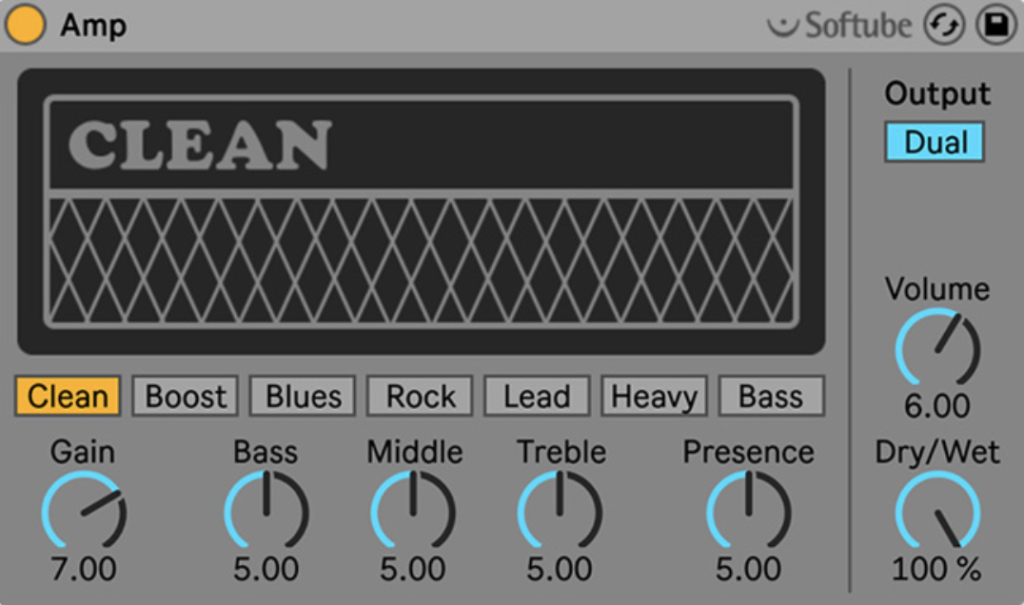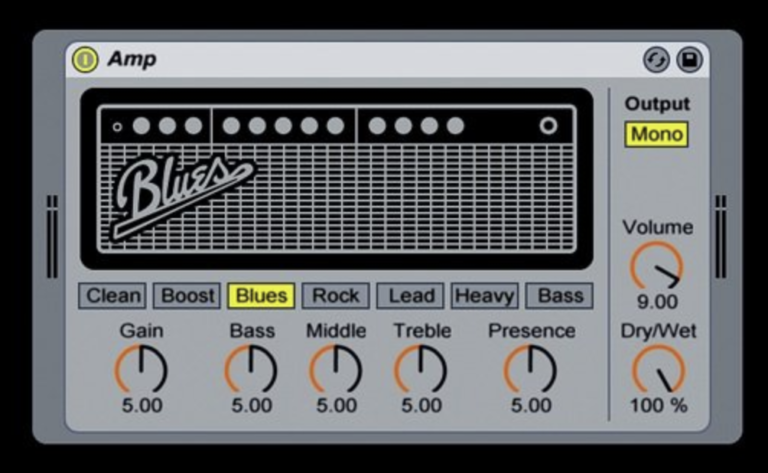Last Updated on January 4, 2024 by IDS Team
Amp by Ableton Live is a divisive topic. Some fans have in fact been extremely disappointed with it. However, what exactly are its good and bad points? Read on for a balanced breakdown of what this plugin does.
What is Good About Amp by Ableton Live?
Ableton’s Amp has gained a bit of notoriety on the internet. However, most critics have tended to be seasoned guitarists. For others, Amp provides good variety, and it’s intuitive and easy to use. The cabinet feature, while possibly unnecessary, is actually quite a nice way to fine-tune your sound. But what else about it is good?
- Amp is a great plugin for those who wish to make the transition from synthesis to guitar. And, in light of the overwhelming amount of choice out there, something familiar for an Ableton user is very welcome. For example, a time-pressed musician who wants to use guitar in otherwise electronic tracks might make good use of it. And Amp contains 8 models apart from its cabinet feature – Clean, Boost, Blues, Rock, Lead, Heavy, and Bass. Together, they provide a varied foundation of sounds to play with.
- Taken as it is, Ableton’s amp plugin is an easy way to get guitar into otherwise synthesis heavy songs. It could work for modern electropop work, and it’s also useful for those who don’t want to go to the trouble of figuring out new software.
- Don’t expect it to have thought of all the features you might need as a proper guitarist. However, if you’re unwilling to switch from Live, Amp could cover you. This might be until you’ve figured out your preferences in terms of other gear on the market. Ableton’s Amp can in this way work like a training ground – but at 69 GBP, many musicians are wondering if it’s worth it.
What is Bad About Amp by Ableton Live?
There is a strong case that Amp is a bit more trouble than it’s worth. Some of the complaints aimed at Ableton’s built-in Amp are to do with its functionality. It’s not a complete plugin like the ones Logic provides.
Instead, it is made up of both the Amp and the Cabinet plugin which follows it – which, while potentially appealing, also complicates it. Together, these two plugins aim to faithfully recreate the sound of an analog tube amplifier – but this is where Amp really falls short.
WHAT ALTERNATIVES ARE THERE?
This is currently a great time for amp sims. Not only has Guitar Rig 6 seen the FIRST update in three years, with Guitar Rig 7, but Amplitube 5 now has integrated TONEX technology.
In shrot, this lends a lot of weight to the argument that Ableton Live’s Amp is more trouble than it’s worth. There are some GREAT alternatives out there and some of them are COMPLETELY FREE. So, what might you look into instead?
- Amplitube Custom Shop
- Guitar Rig 7 Player
Some more expensive (but worth it!) options:
- Guitar Rig 7 Pro
- Helix Native
- Positive grid Bias FX 2
- Neural DSP
We can’t compare Amp to all of these here, but we have reviews in our software section, which we have linked to at the bottom of this article.
So, if Amp doesn’t live up to its claims, then maybe its marketing is misleading. Some fans have criticised it for not accurately representing the models it is based off. Its clear tones are undeniably bright and cheerful. It also creates some cool sounds when Live Effects are added.
However, its emphasis on rich, analog tones seems more like false advertising than reality. Most of the models are decisively thin and tinny. As a result, Amp isn’t even that useful as a cheap and cheerful tool to start off with. In fact, one disgruntled YouTuber billed it as ‘The Worst Amp Ever’.
An Honest Look at the Pros and Cons of Amp by Ableton Live
Was Amp a leap too great for Ableton? Ableton has previously focussed on synthesis and the tools needed for electronic music and beatmaking. It’s come from a totally different mindset and when you examine it, it shows. Resultantly, Amp is a sort of bold attempt at paying homage to something beyond Ableton’s speciality.
Perhaps it was trying to please everyone – catering to electronic musicians and beatmakers, but also hoping to snag new fans. It’s an indicator that they didn’t really do enough investigation into their target market.
The overall conclusion is that Amp isn’t really worth it. It’s not very well designed, and somewhat clunkily built without the preferences of guitarists in mind. To some extent this is inevitable. Ableton never originally intended Live as a form of software for guitarists – instead they aimed it more at looping and synthesis.
Yet, the claims Amp makes about its sound and tonality are only believable if you’re coming from a background in synthesis and electronic music alone, without any experience with guitar.

Is There Anything Unique About Amp?
So, Amp is billed on Ableton’s website as “a physically modeled audio effect that emulates the models of seven classic amps”. One unique feature could be the amp/cabinet split, but as mentioned above, this has both its pros and cons.
Amp’s minimalist interface is another point that stands out, but in comparison with its sound quality, it’s not really unique enough to make it a redeeming feature. The way Amp is advertised makes it sound like a multi-effects rack. Nevertheless, many users would prefer one model that works very well as opposed to seven imperfect ones.
In fact, these amps seem to have served as launchpads for SoftTube to take inspiration from. Ableton claims they have focussed on ‘the essentials’ – tone, vibe, and character’.
This is clearly a plugin that has been designed as a homage to the golden age of analog gear. The fact that the separate cabinet effect is available shows the creators at SoftTube had this in mind. In a way, it’s like they tried to bring to life the recording process of an analog studio. However, there is an air of style over substance, and Amp doesn’t quite have the sparkle needed for those who are familiar with the reality of analog sound.
WHERE DOES AMP BY ABLETON LIVE GO WRONG?
However, there’s an extent to which this analog focus is more of a gimmick. It seems like the designers went for what they THINK musicians want, as opposed to how most users actually work.
With the recent updates to MUCH better amp sims fresh in everyone’s minds, this becomes more and more apparent. Amplitube Custom Shop, for example, attempts to emulate classic tones in a similar way but does it far better.
Ultimately where Amp by Ableton falls short is it doesn’t have any unique feature that makes it worth it. This is in contrast to features like Amplitube’s VIR technology and TONEX integration, or Guitar Rig’s ICM (Intelligent Circuit Modelling) which emulates the system components of classic cabs, amps, and FX pedals down to the individual parts and their internal wiring. In fact, you can read our reviews of Guitar Rig and Amplitube to see why they blow it out of the water. If it did, this might compensate for the lack of quality. Likewise, it leans too much on the idea of analog as a marketing tactic but doesn’t offer the variety and scope of its competitors to appeal to musicians working in many different genres and subgenres.
Final Thoughts:
Ultimately, Ableton Live’s Amp feature isn’t popular. It goes for design, but even in terms of this, there are some obvious errors. To the keen ear, Ableton Live’s amp feature isn’t really worth the time. In addition, there are many other plugins that do the exact same thing. However, if you are a die-heard Ableton Live fan, and don’t have the time to find options – it is usable. Nevertheless, it works best in genres that don’t focus on guitar. In this way, musicians can make it work despite its flaws.
Amp is available from Ableton’s website at 69 GBP or 84 USD at the time of writing.
Liked this article? Find other articles on music software. plugins, and amp simulators in our software category.



